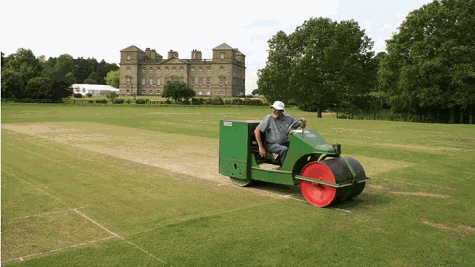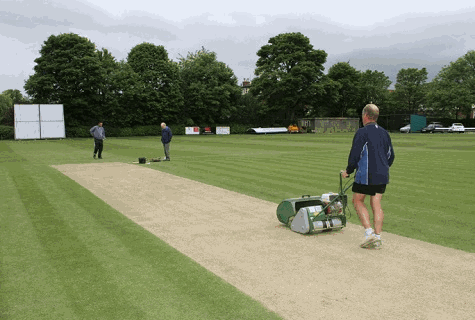This Viewpoint is inspired by a recent debate seen on a Facebook forum for turf professionals, relating to umpires’ markings for cricket pitch performance. For many years this has been a bone of contention and an emotive issue for the professionals who are responsible for preparing these pitches.

In essence it should really be a simple task for the umpire to effectively judge how a pitch consistently performs in response to the bounce and carry of the ball during a cricket match.
However it is often far from that, as there are too many variables and outside influences that can dictate the performance of a given pitch.
Every club ground has its own unique set of issues that may affect the overall performance of a surface during a match. This can also be influenced by the umpire’s own experiences and knowledge of the game, plus their understanding of pitch preparations.
But the biggest problem in my eyes is the fact that there are too many inconsistences in many of the scores these umpires are able to give. This is borne out by some of the postings on the forum.
Quote 1:- I think that so long as a pitch is consistent throughout a match (taking into account weather conditions on the day) then it’s doing its job. I never understood how pitches should be marked on the same parameters as all other pitches when there are so many variables. I have worked with umpires whose knowledge of pitch preparation is limited at best and that does not help.
Quote 2:- I think you have to factor in the standard of cricket being played and if the grounds staff are fully trained, full time, part time or voluntary.
Quote 3:- Assessing a pitch is purely subjective and depends on many factors which are not always connected to the playing surface. How good is the bowling attack? How good are the batters? A medium pace dobber with a bit of swing can look unplayable when the batter isn't very skilled. A genuine quick can get one bouncing past the ears, but is that excessive bounce?
Quote 4:- Don’t get me started on this subject. .OK you have . .I have no idea who draws up the criteria that these umpires work to but they simply need removing for many reasons. They are biased and are hugely prejudiced in the favour of clubs who are very financially secure. Clubs who can’t afford pitch covering, good sightsceeens, sufficient roped boundaries and separate changing facilities are marked down even before the game starts.
Quote 5:- A pitch should be a good balance between bat and ball, but if clubs have better machinery, more time and more man hours they will prepare better pitches in the main, than clubs who don’t. However as long as a pitch is not dangerous and as long as you can see that adequate effort and work has been applied during preparation then how about giving some credit to those clubs?
These are just a few of the passionate postings I have read on this forum that sum up the current problems umpires’ pitch markings are causing in the game today.

Guidelines from the sport’s governing body (ECB) in respect of the criteria that umpires are required to judge the pitch and outfield against are:
• The Pitch (evenness of bounce, seam movement, carry and or bounce and turn).
• The Outfield (Unevenness, Appearance/Grass Length, Boundary Markings and Sightscreens
A copy of a umpires reporting for the Birmingham & District Cricket League document can be seen here.
Every one of these criteria can be seriously influenced by many factors. Pitch preparation, weather conditions, pitch construction, available resources in terms of labour, topography of the site, machinery, irrigation, covers, sightscreens, knowledge and experience of the groundsmen and the players’ ability.
For me it will never be a level playing field. Every pitch will always perform differently on the day of the game. There’s not one groundsman in the UK who knows how the pitch will perform until the first few balls are bowled.

I personally think that the ECB need to have a rethink on the protocols and the marking criteria depending on the level of cricket being played. County / Premier cricket clubs are managed at a completely different level compared to lower level / grassroots cricket clubs.
If a home club wish to leave grass in because they have a good seam attack, does this make it a poor pitch? Good batsmen enjoy the extra zip that a good grass covered pitch provides but a spinner does not. Equally, if a home club want a slow pitch that rags from the start but is consistent with pace and bounce all day, does this make it a poor pitch?
Unfortunately, until the ECB make a change to the setup of pitch markings then we will continue to see umpires poorly adjudicate on the performance of cricket pitches.
We must also remember however, without umpires we have no game. So it is important that umpires, groundstaff and club officials should be working more closely together to improve the consistency and standard of pitches in the UK.
It would also be good for the clubs to invest in an annual independent pitch inspection carried out by a qualified pitch advisor during the playing season to help establish the quality, performance and current condition of their playing surfaces, equipment and facilities of the club.
This annual audit could be a useful means of assessing the club’s needs to ensure they are fit for purpose and able to fulfil its ambitions of serving the community.
The Grounds Management Association (GMA) provide a Pitch Advisory Service (PAS) as part of their ongoing commitment to help improve natural turf provision across football, cricket, rugby union and rugby league at grassroots level in joint collaboration with the England and Wales Cricket Board (ECB), Rugby Football Union (RFU) and Rugby Football League (RFL).